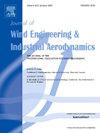A methodology for comparing mean, fluctuating and peak wind loads of buildings
IF 4.9
2区 工程技术
Q1 ENGINEERING, CIVIL
Journal of Wind Engineering and Industrial Aerodynamics
Pub Date : 2025-09-13
DOI:10.1016/j.jweia.2025.106233
引用次数: 0
Abstract
This paper proposes a methodology to distinguish true measurement uncertainty from aerodynamic effects when comparing load coefficients from different atmospheric boundary layer wind tunnels. It considers the similarity of the wind field through profiles of mean velocity, turbulence intensities, and gust factor, along with the distribution of fluctuating flow properties, especially at small scales of turbulence. To ensure consistency, peak wind velocities and responses are estimated from time-histories matched in full-scale sampling time, hence longer records are truncated to match shorter ones.
A test case involving a pressure model of a medium-rise building is proposed. It was independently tested by RWDI, CPP, and Western University under five different conditions. Time-histories of wind velocity and integrated aerodynamic base shear force, overturning, and torsional moments are analyzed and compared for nominally similar exposures. The trends in two comparisons are qualitatively consistent, with discrepancies in mean and peak coefficients not exceeding 7 % and 14 %, respectively. The analysis of the alongwind response reveals even smaller differences, especially in the mean coefficients, even across all five conditions.
These findings suggest that current wind tunnel testing standards could potentially be relaxed, particularly by incorporating Partial Turbulence Simulation concepts, without compromising the reliability of aerodynamic load predictions.
一种比较建筑物平均、波动和峰值风荷载的方法
在比较不同大气边界层风洞的载荷系数时,提出了一种区分真实测量不确定性和气动效应的方法。它通过平均速度、湍流强度和阵风因子的分布以及脉动流特性的分布来考虑风场的相似性,特别是在小尺度湍流中。为了确保一致性,峰值风速和响应是根据与全尺寸采样时间匹配的时程估计的,因此较长的记录被截断以匹配较短的记录。提出了一个涉及中高层建筑压力模型的测试用例。由RWDI、CPP和Western University在五种不同条件下进行独立测试。在名义上相似的暴露情况下,风速和综合气动基础剪切力、倾覆和扭转力矩的时程进行了分析和比较。两种比较的趋势在质量上是一致的,平均系数和峰值系数的差异分别不超过7%和14%。对顺风响应的分析揭示了更小的差异,特别是在平均系数上,即使在所有五种情况下也是如此。这些发现表明,目前的风洞测试标准有可能被放宽,特别是通过纳入部分湍流模拟的概念,而不会影响气动载荷预测的可靠性。
本文章由计算机程序翻译,如有差异,请以英文原文为准。
求助全文
约1分钟内获得全文
求助全文
来源期刊
CiteScore
8.90
自引率
22.90%
发文量
306
审稿时长
4.4 months
期刊介绍:
The objective of the journal is to provide a means for the publication and interchange of information, on an international basis, on all those aspects of wind engineering that are included in the activities of the International Association for Wind Engineering http://www.iawe.org/. These are: social and economic impact of wind effects; wind characteristics and structure, local wind environments, wind loads and structural response, diffusion, pollutant dispersion and matter transport, wind effects on building heat loss and ventilation, wind effects on transport systems, aerodynamic aspects of wind energy generation, and codification of wind effects.
Papers on these subjects describing full-scale measurements, wind-tunnel simulation studies, computational or theoretical methods are published, as well as papers dealing with the development of techniques and apparatus for wind engineering experiments.

 求助内容:
求助内容: 应助结果提醒方式:
应助结果提醒方式:


